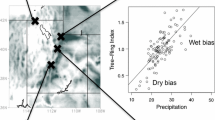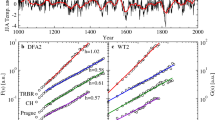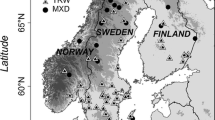Abstract
We explore a probabilistic, hierarchical Bayesian approach to the simultaneous reconstruction of local temperature and soil moisture from tree-ring width observations. The model explicitly allows for differing calibration and reconstruction interval responses of the ring-width series to climate due to slow changes in climatology coupled with the biological climate thresholds underlying tree-ring growth. A numerical experiment performed using synthetically generated data demonstrates that bimodality can occur in posterior estimates of past climate when the data do not contain enough information to determine whether temperature or moisture limitation controlled reconstruction-interval tree-ring variability. This manifestation of nonidentifiability is a result of the many-to-one mapping from bivariate climate to time series of tree-ring widths. The methodology is applied to reconstruct temperature and soil moisture conditions over the 1080–1129 C.E. interval at Methusalah Walk in the White Mountains of California, where co-located isotopic dendrochronologies suggest that observed moisture limitations on tree growth may have been alleviated. Our model allows for assimilation of both data sources, and computation of the probability of a change in the climatic controls on ring-width relative to those observed in the calibration period. While the probability of a change in control is sensitive to the choice of prior distribution, the inference that conditions were moist and cool at Methuselah Walk during the 1080–1129 C.E. interval is robust. Results also illustrate the power of combining multiple proxy data sets to reduce uncertainty in reconstructions of paleoclimate.






Similar content being viewed by others
Notes
M. Schofield et al., abstract 306105 of the 2012 Joint Statistical Meetings.
Werner, J.P. and Tolwinski-Ward, S.E., poster PP51A-1913 of the American Geophysical Union Fall Meeting (2013).
References
Bale R, Robertson I, Salzer M, Loader N, Leavitt S, Gagen M, Harlan T, McCarroll D (2011) An annually resolved bristlecone pine carbon isotope chronology for the last millennium. Quatern Res 76(1):22–29. doi:10.1016/j.yqres.2011.05.004
Bradley R (1999) Paleoclimatology: reconstructing climates of the quaternary. Academic Press, San Diego, CA
Bradley R (2011) High-resolution paleoclimatology. In: Hughes M, Swetnam T, Diaz H (eds) Dendroclimatology: progress and prospects, developments in paleoecological research, Chapter 1. Springer, Berlin
Brazdil R, Pfister C, Wanner H, Von Storch H, Luterbacher J (2005) Historical climatology in Europe: the state of the art. Clim Change 70:363–430. doi:10.1007/s10584-005-5924-1
Breitenmoser P, Brönnimann S, Frank D (2013) Forward modelling of tree-ring width and comparison with a global network of tree-ring chronologies. Clim Past Discuss 9(4):4065–4098. doi:10.5194/cpd-9-4065-2013. http://www.clim-past-discuss.net/9/4065/2013/
Chiles J, Delfiner P (1999) Geostatistics: modeling spatial uncertainty. Wiley Series in Probability and Statistics, New York, NY
Christiansen B, Ljungqvist F (2011) Reconstruction of the extratropical NH mean temperature over the last millennium with a method that preserves low-frequency variability. J Clim 24:6013–6034. doi:10.1175/2011JCLI4145.1
Cook E, Kairiukstis L (1990) Methods of Dendrochronology: applications in the environmental sciences. Kluwer Academic Publishers, Dordrecht
Cook E, Seager R, Heim R, Vose R, Herweijer C, Woodhouse C (2009) Megadroughts in North America: placing IPCC projections of hydroclimatic change in a long-term paleoclimate context. J Quat Sci 25:48–61. doi:10.1002/jqs.1303
Crowley T, Lowery T (2000) How warm was the medieval warm period? AMBIO 29:51–54. doi:10.1639/0044-7447(2000
Csillery K, Blum M, Gaggiotti O, Fracois O (2010) Approximate Bayesian computation (ABC) in practice. Trends Ecol Evol 25:410–418. doi:10.1016/j.tree.2010.04.001
Daly C, Halbleib M, Smith J, Gibson W, Doggett M, Taylor G, Curtis J, Pasteris P (2008) Physiographically sensitive mapping of climatological temperature and precipitation across the coterminous United States. Int J Climatol 28:2031–2064. doi:10.1002/joc.1688. http://www.prism.oregonstate.edu/
D’Arrigo R, Kaufmann R, Davi N, Jacoby G, Laskowski C, Myneni R, Cherubini P (2004) Thresholds for warming-induced growth decline at elevational treeline in the Yukon Territory. Glob Biogeochem Cycles 18. doi:10.1029/2004GBO02249
D’Arrigo R, Wilson R, Jacoby G (2006) On the long-term context for late twentieth century warming. J Geophys Res 111. doi:10.1029/2005JD006352
Evans M, Tolwinski-Ward S, Thompson D, Anchukaitis K (2013) Applications of proxy system modeling in high resolution paleoclimatology. Quat Sci Rev 76(0):16–28. doi:10.1016/j.quascirev.2013.05.024. http://www.sciencedirect.com/science/article/pii/S0277379113002011
Farquhar G, O’Leary MH, Berry JA (1982) On the relationship between carbon isotope discrimination and the intercellular carbon dioxide concentration in leaves. Aust J Plant Physiol 9:121–37
Fritts HC (2001) Tree rings and climate. The Blackburn Press, New York
Fritts HC, Smith DG, Cardis JW, Budelsky C (1965) Tree-ring characteristics along a vegetation gradient in northern Arizona. Ecology 46:394–401. http://www.jstor.org/stable/1934872
Garetta V, Guiot J, Mortier F, Chadoef J, Hely C (2012) Pollen-based climate reconstruction: calibration of the vegetation–pollen processes. Ecol Mod 235–236:81–94. doi:10.1016/j.ecolmodel.2012.03.031
Gelman A, Rubin D (1992) Inference from iterative simulation using multiple sequences. Stat Sci 7(4):457–472. doi:10.1214/ss/1177011136
Gelman A, Carlin J, Stern H, Rubin D (2003) Bayesian data analysis. Chapman and Hall, Boca Raton, FL
Gilks W, Richardson S, Spiegelhalter D (1996) Markov chain Monte Carlo in practice. Chapman & Hall/CRC, Boca Raton
Graham N, Hughes M (2007) Reconstructing the Mediaeval low stands of Mono Lake, Sierra Nevada, California USA. Holocene 17(8):1197–1210. doi:10.1177/0959683607085126
Guiot J, Torre F, Jolly D, Peyron O, Boreaux J, Cheddadi R (2000) Inverse vegetation modeling by monte carlo sampling to reconstruct palaeoclimates under changed precipitation seasonality and CO2 conditions: application to glacial climate in Mediterranean region. Ecol Model 127:119–1140
Guiot J, Wu V Garreta, HB, Hatte C, Magny M (2009) A few prospective ideas on climate reconstruction: from a statistical single proxy approach towards a multi-proxy and dynamical approach. Clim Past 5:571–583. www.clim-past.net/5/571/2009/
Haslett J, Whiley M, Bhattacharya S, Salter-Townshend M, Wilson S, Allen J, Huntley B, Mitchell F (2006) Bayesian paleocolimate reconstruction. J R Stat Soc 169(3):395–438. doi:10.1111/j.1467-985X.2006.00429.x
Huang J, van den Dool HM, Georgankakos KP (1996) Analysis of model-calculated soil moisture over the United States (1931–1993) and applications to long-range temperature forecasts. J Clim 9:1350–1362
Hughes M, Funkhouser G (1998) Extremes of moisture availability reconstructed from tree rings for recent millennia in the Great Basin of Western North America. In: Beniston M, Innes J (eds) The impacts of climate variability on forests. Springer, Berlin, pp 99–107
Hughes MK, Ammann CM (2009) The future of the past: an earth system framework for high resolution paleoclimatology—editorial essay. Clim Change 94:247–259. doi:10.1007/s10584-009-9588-0
Jansen E, Overpeck J, Briffa K, Duplessy J, Joos F, Masson-Delmotte V, Olago D, Otto-Bliesner B, Peltier W, Rahmstorf S, Ramesh R, Raynaud D, Rind D, Solomina O, Villalba R, Zhang D (2007) Paleoclimate, Chap 6. In: Solomon S, Qin D, Manning M, Chen Z, Marquis M, Averyt K, Tignor M, Miller H (eds) Climate change 2007: the physical science basis. Contribution of working group I to the fourth assessment report of the intergovernmental panel on climate change. Cambridge University Press, Cambridge
Jones P, Briffa K, Barnett T, Tett S (1998) High-resolution paleoclimatic records for the last millennium: interpretation, integration and comparison with general circulation model control-run temperatures. Holocene 8:455–471. doi:10.1191/095968398667194956
Kobashi T, Severinghaus JP, Brook EJ, Barnola JM, Grachev AM (2007) Precise timing and characterization of abrupt climate change 8200 years ago from air trapped in polar ice. Quat Sci Revs
LaMarche V (1974) Paleoclimatic inferences from long tree-ring records. Science 183(4129):1043–1088
Leavitt S (1994) Major wet interval in White Mountains medieval warm period evidenced in \(\delta ^{13}\)C of bristlecone pine tree rings. Clim Change 26:299–307
Li B, Nychka D, Ammann C (2010) The value of multiproxy reconstructions of past climate. J Am Stat Assoc 105(491):883–895
Luterbacher J, Dietrich D, Xoplaki E, Grosjean M, Wanner H (2004) European seasonal and annual temperature variability, trends, and extremes since 1500. Science 303(5663):1499–1503. doi:10.1126/science.1093877
Mann ME, Zhang Z, Hughes MK, Bradley RS, Miller SK, Rutherford S, Ni F (2008) Proxy-based reconstructions of hemispheric and global surface temperature variations over the past two millennia. Proc Natl Acad Sci USA 105:13,252–13,257. doi:10.1073/pnas.0805721105
McCarroll D, Loader N (2004) Stable isotopes in tree rings. Quat Sci Rev 23:771–801. doi:10.1016/j.quascirev.2003.06.017
Moberg A, Sonechkin D, Holmgren K, Datsenko N, Karlen W (2005) Highly variable Northern Hemisphere temperatures reconstructed from low- and high-resolution proxy data. Nature 433:613–617. doi:10.1038/nature03265
Murray I, Ghahramani Z, MacKay DJC (2006) MCMC for doubly-intractable distributions. In:Proceedings of the 22nd Annual Conference on Uncertainty in Artificial Intelligence (UAI-06), pp 359–366
Parnell A, Haslett J, Allen J, Buck C, Huntley B (2008) A flexible approach to assessing synchroneity of past events using Bayesian reconstructions of sedimentation history. Quat Sci Rev 27(19–20):1872–1885. doi:10.1016/j.quascirev.2008.07.009
Robert C (2007) The bayesian choice: from decision-theoretic foundations fo computational implementation. Springer Texts in Statistics, Paris
Salzer M, Bunn A, Graham N, Hughes M (2013) Five millennia of paleotemperature from tree-rings in the Great Basin, USA. Clim Dyn 1–10. doi:10.1007/s00382-013-1911-9
Salzer MW, Hughes MK, Bunn AG, Kipfmueller KF (2009) Recent unprecedented tree-ring growth in bristlecone pine at the highest elevations and possible causes. Proc Natl Acad Sci USA 106:20,348–20,353. doi:10.1073/pnas.0903029106
Shashkin A, Vaganov E (1993) Simulation model of climatically determined variability of conifers annual increment (on the example of common pine in the steppe zone). Rus J Ecol 24(5):275–280
Smerdon J (2012) Climate models as a test bed for climate reconstruction methods: pseudoproxy experiments. WIREs Clim Change 3:63–77. doi:10.1002/wcc.149
Stanhill G, Cohen S (2001) Global dimming: a review of the evidence for a widespread and significant reduction in global radiation with discussion of its probable causes and possible agricultural consequences. Agric For Meteorol 107:255–278. doi:10.1016/S0168-1923(00)00241-0
Stine S (1990) Late Holocene fluctuations in Mono lake, eastern California. Paleogeography, paleoclimatology, palaeoecology 78:333–381. doi:10.1016/0031-0182(90)90221-R
Stine S (1994) Extreme and persistent drought in California and Patagonia during Mediaeval time. Nature 369:546–549. doi:10.1038/369546a0
Stokes M, Smiley T (1968) An introduction to tree-ring dating. University of Chicago Press, Chicago
Tingley M, Huybers P (2010a) A Bayesian algorithm for reconstructing climate anomalies in space and time. Part I: development and applications to paleoclimate reconstruction problems. J Clim 23:2759–2781. doi:10.1175/2009JCLI3015.1
Tingley M, Huybers P (2010b) A Bayesian algorithm for reconstructing climate anomalies in space and time. Part II: comparison with the regularized expectation-maximization algorithm. J Clim 23:2782–2800. doi:10.1175/2009JCLI3016.1
Tingley M, Huybers P (2013) Recent temperature extremes at high northern latitudes unprecedented in the past 600 years. Nature 496(7444):201–205. doi:10.1038/nature11969
Tingley M, Craigmile P, Haran M, Li B, Mannshardt-Shamseldin E, Rajaratnam B (2012) Piecing together the past: statistical insights into paleoclimatic reconstructions. Quat Sci Rev 35:1–22. doi:10.1016/j.quascirev.2012.01.012
Tolwinski-Ward S, Evans M, Hughes M, Anchukaitis K (2011) An efficient forward model of the climate controls on interannual variation in tree-ring width. Clim Dyn doi:10.1007/s00382-010-0945-5
Tolwinski-Ward S, Anchukaitis K, Evans M (2013) Bayesian parameter estimation and interpretation for an intermediate model of tree-ring width. Clim Past 9:1481–1493. doi:10.5194/cp-9-1481-2013
Vaganov E, Hughes M, Kirdyanov A, Schweingruber F, Silkin P (1999) Influence of snowfall and melt timing on tree growth in subarctic Eurasia. Nature 400:149–151. doi:10.1038/22087
Vaganov E, Hughes M, Shashkin A (2006) Growth dynamics of conifer tree rings: images of past and future environments. Springer Ecol. Stu. 183, New York
Wahl E, Diaz H, Ohlwein C (2011) A pollen-based reconstruction of summer temperature in central North America and implications for circulation patterns during medieval times. Glob Planet Change. doi:10.1016/j.gloplacha.2011.10.005
Yu S, Kang Z, Zhou W (2012) Quantitative palaeoclimate reconstructions as an inverse problem: A Bayesian inference of late-Holocene climate on the eastern Tibetan Plateau from a peat cellulose \(\delta ^{18}\)O record. Holocene 22(405). doi:10.1177/0959683611425544
Acknowledgments
This work was supported in part by Grants NSF ATM-0724802, NSF ATM-0902715, NSF DMS-1204892, NSF AGS 1304309, and NOAA NA060OAR4310115. We thank Steve Leavitt for lending his isotope data as well as insights on their interpretation, Chris Daly and the PRISM project for making their work freely available, and Benno Blumenthal for making the PRISM data easily accessible on the IRI Data Library. We are also grateful for insightful comments from Chris Paciorek and one other anonymous reviewer, which substantially improved the final version of this paper.
Author information
Authors and Affiliations
Corresponding author
Additional information
S.E. Tolwinski-Ward performed the research and submitted the article while at the Institute for Mathematics Applied to Geosciences, National Center for Atmospheric Research, Boulder, CO, 80305.
Electronic supplementary material
Below is the link to the electronic supplementary material.
Appendix: Sampling algorithm
Appendix: Sampling algorithm
Posterior sampling is complicated by the many-to-one mapping from climate to tree-ring width inherent to the VS-Lite model. As a result, it is usually possible to construct many hot, dry moisture-limited climate histories as well as many cool, wet temperature-limited ones with the same likelihood from a given series of interannaul ring-width variations. The nonidentifiability between hot and dry solutions versus cool and wet solutions is related to the switching in the controls on tree-ring growth that can occur with large shifts in the low-frequency climatology, and results in bimodality in the posterior distribution of \(\varDelta T\) and \(\varDelta M\). This feature of the problem precludes the use of standard Gibbs sampling approaches, in which each variable in the problem is iteratively sampled from its full conditional given the current value of all others unknowns (Gilks et al. 1996). Fixed values of the (2-variable \(\times\) 12-month \(\times\) N-year) histories of climatic anomalies \(\varvec{T}', \varvec{M}'\) will only be consistent with either a hot, dry climate and moisture-limited growth, or with a cool, wet climate and temperature-limited growth, and so a straightforward Gibbs sampler does not permit transitions between the two modes of the posterior of \(\varDelta T\) and \(\varDelta M\). The posterior is of the "doubly intractable" form discussed by Murray et al. (2006).
Further nonidentifiability stems from the finer time-scale of the monthly climatic variations compared to the annual resolution of the data, as there are many ways to configure monthly climate variations resulting in the same annual growth. Thus, for a given shift in climatology captured by non-zero values of \(\varDelta T\) and \(\varDelta M\), and conditional on the parameters of VS-Lite controlling the growth response, a relatively long “burn-in” period is necessary to wander through the (2-variable \(\times\) 12-month \(\times\) N-year) space of \(\varvec{T}', \varvec{M}'\) histories to find the region of state space that is statistically consistent with both the data and the prior.
Given these complications, we employ a hybrid of Gibbs and Metropolis–Hastings sampling techniques, as well as an approximation of the likelihood using summary statistics and simulation as in Approximate Bayesian Computation approaches (Csillery et al. 2010) to numerically estimate the posterior. The approximation to the likelihood is based on the following intuition: variations in the climatological shifts \((\varDelta T, \varDelta M)\) tend to influence the mean and variance of simulated tree-ring width time series, while the climatic anomalies \(T', M'\) mainly control the relative interannual variations in ring width index. By treating the ring-width series as a set of variations about its sample mean with scale given by the sample standard deviation, and by treating the sample mean and variance as sufficient statistics for \(\varDelta T\) and \(\varDelta M\), we can solve an approximation to the problem, with the likelihood in Eq. 11 approximated by
The sampling for the pseudoproxy problem then proceeds in two separate steps:
-
1.
Draw a proposal from the prior \([\varDelta T, \varDelta M]\), and a Monte Carlo sample of size 100 from \([\varvec{T}',\varvec{M}']\) (sampled from Eq. 9 using the fixed values of covariance matrices \(S_s\) and temporal autocorrelation parameters \(\phi _1\) and \(\phi _2\) estimated in the calibration interval). Use these as inputs to the data-level model Eq. 6 to compute a Monte Carlo sample \(\{\bar{W}_{MC},S^2_{MC}\}_{n = 1}^{100}\) of the sample mean and standard deviation of the simulated ring-width index time series. Accept or reject the proposed values of \(\varDelta T, \varDelta M\) (as in a Metropolis–Hastings sampler) depending on the distance of the Monte Carlo sample means of the two sample statistics from the observed values. The likelihood is a normal distribution of the means of the Monte Carlo sample statistics about the observed values, with standard deviations given by the Monte Carlo standard errors. We run this step in series on a laptop. The resulting samples \(\{\varDelta T^{(n)},\varDelta M^{(n)}\}_{n=1}^N\) approximate the distribution \([\varDelta T, \varDelta M | \bar{W},s^2_W] \approx [\varDelta T, \varDelta M | \varvec{W}]\).
-
2.
Using the Metropolis–Hastings within Gibbs algorithm (Gilks et al. 1996), draw \(n = 1, \ldots , N_{MC}\) samples of the monthly-resolved bivariate time series from
$${}[\varvec{T}',\varvec{M}'|\varDelta T^{(n)}, \varDelta M^{(n)},\varvec{W}] \propto [\varvec{W}|\varvec{T}',\varvec{M}',\varDelta T^{(n)},\varDelta M^{(n)}][\varvec{T}',\varvec{M}']$$for each of the samples of the climatic shifts from Step 1, where the first factor on the right-hand side is given by our VS-Lite data-level model, and the second is given by the prior model (Eq. 9) for the climatic anomalies. We use a burn-in period of 75 iterations, which was deemed appropriate after diagnosis of multiple MCMC chains examining trace plots, autocorrelation plots, and the \(\hat{R}\) statistic of Gelman and Rubin (1992) for our sample chains. We parallelize this step and draw the samples in a high-performance computing (HPC) environment.
The sampler for the reconstructions based on real tree-ring data at Methuselah walk proceeds similarly, except that \(\varvec{\theta }_W\) must also be inferred. Because the elements of \(\varvec{\theta }_W\) depend only on calibration-interval temperature, moisture, and ring-width data (\(\varvec{W}_c,\varvec{T}_c,\varvec{M}_c\)), this sampling can be performed separately, and we draw samples from \([\varvec{\theta }_W | \varvec{W}_c,\varvec{T}_c,\varvec{M}_c]\) using the algorithm and freely available code detailed in Tolwinski-Ward et al. (2013). The likelihoods in Steps 1 and 2 also depend, in the real-data reconstructions, on the sampled values of (\(\varvec{\theta }_w, \varvec{W}_c,\varvec{T}_c,\varvec{M}_c\)), which serve as inputs to VS-Lite. For inference conditioned on both tree-ring width and isotope data, the dependence of the sampler on the isotopes enters during the drawing of proposals for the Metropolis–Hastings sampler in Step 1, by drawing proposals of \(\varDelta M\) conditional on the mean del-index \(\bar{I}_\delta\).
All sampling was coded and run in MATLAB®. The CPU time for each step and each experiment is given in the Table 2.
Rights and permissions
About this article
Cite this article
Tolwinski-Ward, S.E., Tingley, M.P., Evans, M.N. et al. Probabilistic reconstructions of local temperature and soil moisture from tree-ring data with potentially time-varying climatic response. Clim Dyn 44, 791–806 (2015). https://doi.org/10.1007/s00382-014-2139-z
Received:
Accepted:
Published:
Issue Date:
DOI: https://doi.org/10.1007/s00382-014-2139-z




